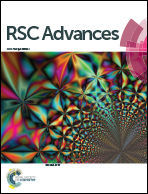Synthesis, crystal structure, fluorescence and antimicrobial activity of a series of rare-earth complexes based on indolebutyric acid†
Abstract
A series of lanthanide complexes, namely, [Ln(IBA)3(phen)]·(Hphen)·NO3·xH2O·yEtOH (1–6) (Ln = La (1), x = 1, y = 0.5; Pr (2), x = 2, y = 0; Eu (3), x = 2, y = 0; Gd (4), x = 2, y = 0; Tb (5), x = 1.5, y = 0; Yb (6), x = 2, y = 0. IBA = indole-3-butyric acid, phen = 1,10-phenanthroline), [Sm(IBA)2(phen)2]·NO3 (7) and Ln(IBA)3(phen) (8–10) (Ln = Eu (8); Tb (9); Yb (10)), was synthesized successfully. All the complexes were characterized by elemental analysis, IR spectroscopy, UV-vis spectrophotometry, thermal gravimetric technology, powder X-ray diffraction and single-crystal X-ray diffraction. Structural analyses revealed that each lanthanide atom has a distorted tricapped trigonal prism geometry with a nine-coordinate mode in complexes 1–9 and has a bicapped trigonal prism geometry with an eight-coordinate mode in complex 10. There are three kinds of coordination modes of IBA ligands in complexes 1–6 and 8, 9: a μ1-η1:η1 bidentate chelating mode, a μ2-η1:η1 double monodentate bridging mode and a μ2-η1:η2 bridging mode. For complex 7, there are two kinds of coordination mode of IBA ligands: a μ2-η1:η1 and a μ2-η1:η2 bridging modes. For complex 10, there are also two kinds of coordination mode of IBA ligands, a μ2-η1:η1 double monodentate bridging mode and a μ1-η1:η1 bidentate chelating mode. Adjacent lanthanide atoms are linked via the μ2-bridging carboxylate groups of the IBA ligands to generate a binuclear building unit. In addition, their photoluminescent characterization and antimicrobial activity against the fungi Golden staph (G.S), Pseudomonas aeruginosa (P.A), Escherichia coli (E.C), Bacillus subtillis (B.S) and Candida albicans (C.A) were studied.


 Please wait while we load your content...
Please wait while we load your content...